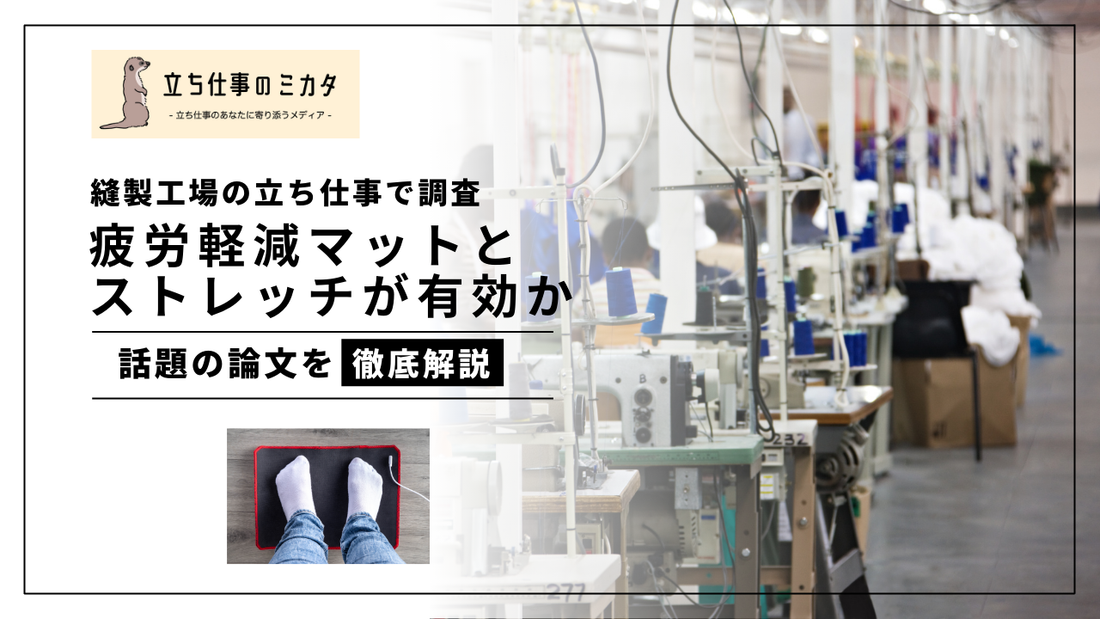
Are mats and stretching effective in preventing musculoskeletal disorders (MSDs)? An analysis of a study verifying their effectiveness in standing work in sewing factories
Share
- Introduction
- Research Summary
- The role and limitations of anti-fatigue mats
- The effectiveness and challenges of stretching
- Why anti-fatigue mats and stretching are the perfect combination
- Practical Recommendations
- Conclusion
- Do you have any problems with standing for long periods of time?
- A new idea called "standing rest" that reduces the strain of standing posture!
- Device to reduce the strain of standing work
- Reduce physical stress
- Related articles
Introduction
Musculoskeletal disorders (MSDs) are serious health issues that affect approximately 1.7 billion people worldwide, with the risk being particularly high in occupations that involve standing. In this article, we examine the effects of anti-fatigue mats and stretching exercises based on a study conducted in a garment factory in Indonesia, and consider optimal fatigue reduction measures.
Research Summary
In this study, 112 workers in an Indonesian garment factory were divided into four groups, and each group underwent a five-day experiment under different conditions. The research method used was to measure the levels of MSDs using the Nordic Body Map (NBM), and statistically analyze the changes before and after the intervention (using paired T-test).
| group | Anti-fatigue mat used | Stretching | Results (MSDs reduction effect) | P-Value |
|---|---|---|---|---|
| T0 | ❌ | ❌ | Worsening of MSDs confirmed | 0.010 |
| T1 | ❌ | ✅ | no change | 0.745 |
| T2 | ✅ | ❌ | no change | 0.326 |
| T3 | ✅ | ✅ | MSDs were significantly reduced | 0.006 |
As a result, it was found that the anti-fatigue mat alone or stretching alone did not have any effect on reducing MSDs, and significant improvement was observed only when the two were combined .
The role and limitations of anti-fatigue mats
Anti-fatigue mats are made of flexible materials such as PVC foam, and they distribute pressure on the soles of the feet and prevent blood flow from stagnation . However, as the results of this study show, anti-fatigue mats alone did not significantly reduce MSDs . This is thought to be because sustained muscle contraction caused by standing for long periods of time leads to poor circulation of blood, resulting in the accumulation of fatigue.
In fact, a study by Redfern and Cham (2000) found that prolonged standing on a hard surface significantly increased lower limb muscle fatigue and lower back discomfort.


The effectiveness and challenges of stretching
Stretching is said to contribute to reducing fatigue by improving muscle flexibility and promoting blood flow. However, in this study, stretching alone did not result in a significant reduction in MSDs (p = 0.745) . This may be due to the accuracy of the worker's stretching practice and form.
On the other hand, a study by Gasibat et al. (2017) showed that proper stretching improves muscle viscoelasticity and promotes blood flow. Therefore, in order to maximize the effect of stretching, it is necessary to perform it under proper guidance .
Why anti-fatigue mats and stretching are the perfect combination
The results of this study revealed that the combination of anti-fatigue mat and stretching (T3 group) was the only condition that significantly reduced MSDs (p = 0.006).
The factors behind this include:
- The anti-fatigue mat distributes pressure on the soles of your feet and prevents blood flow from stagnating.
- Stretching increases muscle flexibility and improves blood flow.
In particular, a study by Winberg et al. (2022) reported that a properly designed anti-fatigue mat promotes activation of lower limb muscles during static standing tasks and reduces strain during long periods of standing work.
Practical Recommendations
Based on the results of this study, the following measures should be implemented in workplaces where standing is the norm:
1. Introduction of anti-fatigue mats
- Use highly cushioned anti-fatigue mats in workplaces where workers stand for long periods of time.
- Check the condition of the mats regularly and replace any that are worn out.
2. Stretch regularly
- We recommend stretching for at least three minutes every two hours .
- Pay particular attention to stretching the ankles, calves, and lower back.
3. Improving the working environment
- Wear suitable work shoes (arch support recommended).
- Optimize break times (take frequent short breaks).
Conclusion
The results of this study clarified that the combination of anti-fatigue mats and stretching is the most effective way to reduce MSDs caused by standing work . Companies and workplace managers should use this knowledge to improve the work environment.

